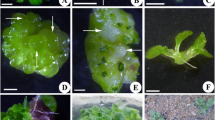Summary
A procedure for plant regeneration, flower and plant formation from petiolar and inflorescence nodal explants of culantro is discribed. Leaf petioles were excised from young leaves of non-flowering plants while nodal explants were excised from the inflorescence. Explants were cultured in Murashige and Skoog (MS) medium alone or supplemented with 0.5μM naphthaleneacetic acid (NAA) and 0.9, 1.8, 4.5, or 9 μM thidiazuron (TDZ). All explants produced multiple shoots. In addition, nodal explants formed flowers. Shoot number, flower number and shoot length were influenced by TDZ and NAA. Rooted shoots from both types of explants were transferred to soil where plants were successfully established.
Similar content being viewed by others
References
Arockiasamy, S.; Ignacimuthu, S. Plant regeneration from mature leaves and roots of Eryngium foetidum L., a food flavouring agent. Curr. Sci. 75:664–666; 1998.
Daniel, B.; Simpson, B.; Lawrence, B.; Nair, G. M.; Edison, S. Rapid in vitro multiplication of Eryngium foetidum L., an aromatic spice, through shoot multiplication and organogenesis. Proc. National Seminar Biotechnol. Spices Arom. Plants, Calicut, India; 1997: 51–55.
Garcia, M. D.; Saenz, M. T.; Gomez, M. A.; Fernandez, M. A. Topical antiinflammatory activity of phytosterols isolated from Eryngium foetidum on chronic and acute inflammation models. Phytotherapy Res. 13:78–80; 1999.
Ignacimuthu, S.; Arockiasamy, S.; Antonysamy, M.; Ravichandran, P. Plant regeneration through somatic embryogenesis from mature leaf explants of Eryngium foetidum, a condiment. Plant Cell Tiss. Organ Cult. 56:131–137; 1999.
Kuebel, K. R.; Tucker, A. O. Vietnamese culinary herbs in the United States. Econ. Bot. 42:413–419; 1988.
Mohamed-Yasseen, Y. In vitro flowering and plant formation from nodal explants of culantro (Eryngium foetidum L.). PGRSA Quarterly 22:21 (Abstr.); 1994.
Mohamed-Yasseen, Y. Plant regeneration and shoot proliferation from culantro (Eryngium foetidum L.). Bull. Fac. Agric. Cairo Univ. (in press); 2002.
Mohamed-Yasseen, Y.; Splittstoesser, W. E. In vitro regeneration of plants from stored Witloof chicory (Cichorium intybus L.). PGRSA Quarterly 19:41–45; 1991.
Mohamed-Yasseen, Y.; Splittstoesser, W. E. Multiplication of Cyperus alternfolius from axillary buds in vitro: instructive laboratory exercises. PGRSA Quarterly 20:83–89; 1992.
Morton, J.; Zallinger, J. Herbs and spices. New York: Golden Press; 1976:160.
Murashige, T.; Skoog, F. A revised medium for rapid growth and bioassays with tobacco tissue cultures. Physiol. Plant. 15:473–497; 1962.
Saenz, M. T.; Fernandez, M. A.; Garcia, M. D. Antiinflammatory and analgesic properties from leaves of Eryngium foetidum L. (Apiaceae). Phytotherapy Res. 11:380–383; 1997.
Author information
Authors and Affiliations
Corresponding author
Rights and permissions
About this article
Cite this article
Mohamed-Yasseen, Y. In vitro regeneration, flower and plant formation from petiolar and nodal explants of culantro (Eryngium foetidum L.). In Vitro Cell Dev Biol -Plant 38, 423–426 (2002). https://doi.org/10.1079/IVP2002311
Received:
Accepted:
Issue Date:
DOI: https://doi.org/10.1079/IVP2002311




